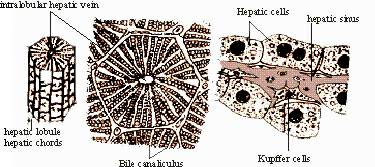|
PinkMonkey Online Study Guide-Biology
Histology of liver :
It is the largest gland externally covered by a thin membrane called Glissonís
capsule which extends into the substance of the liver, dividing it
into a number of hepatic lobules.

Figure 16.12 Various views of
liver. (A) Hepatic lobule (diagrammatic)
(B) Hepatic lobule (magnified) (C) Sinusoid
Each hepatic lobule
is a hexagonal or prismatic structure covered by a thin membrane,
the part of Glissonís capsule, and the connective tissue enclosing
the arteriole, venule and tributaries or the hepatic portal vein.
In the center of each lobule is seen a canal called the intra-lobular
canal or tributary of the hepatic vein. The substance of a lobule
is made up of many radially arranged branched, plate-like structures
called hepatic cords. Each hepatic cord is usually made up
of two rows of hepatic cells. In between the hepatic cells of each
cord is seen the bile canaliculus in which bile flows from
adjoining cells. Similarly in between the cords are seen blood
canaliculi and sinusoids. The flow of bile is from the center
to the periphery while that of blood is from periphery towards the
center. The sinusoids are lined by incomplete endothelial cells
called Kupfferís cells. These cells are amoeboid and phagocytic
in their functioning. They also engulf dead and worn out red blood
cells.
The hepatic cells are polygonal, each with a
distinct centrally placed spherical nucleus and granular cytoplasm. The
cytoplasm is rich in granules of glycogen, fat droplets and pigment granules.
Histology of pancreas: Pancreas is composed of
a large aggregation of alveoli with ducts hence it is sometimes called
the tubuo-alveolar gland. When observed in a transverse section,
these alveoli appear as vesicles, the shape of which varies according
to the plane of the section. The alveoli and their ducts are joined by
a thin connective tissue, blood capillaries and nerve fibers. The pancreas
is essentially made up of two parts, the non-endocrine or exocrine,
and the endocrine portions.
The exocrine part of the pancreas consists of
numerous pancreatic secretory components known as alveoli or acini.
Each acinus consists of a number of pyramidal or conical secretory cells
surrounding a central lumen. The secretory cells of the acini contain
distinct nuclei, mitochondria, and ribosomes generally situated towards
the base, and zymogen or secretory granules aggregated towards the lumen
along with the Golgi complex. The nucleoli are conspicuously seen in the
nuclei. The acini secrete pancreatic juice.
The endocrine part consists
of chords of loosely arranged cells seen as isolated masses of cells in
a transverse section surrounded by a large number of blood capillaries.
These are known as the "Islets of Langerhans". The islets
include three types of cells, namely alpha (a),
beta (b) and
delta (d) cells.
The d-islet cells secrete the hormone glucagon which increases
the blood sugar level while islet cells secrete the hormone insulin
which decreases blood sugar level by triggering cells to absorb glucose.
Thus, an antagonistic effect of these two hormones controls sugar metabolism.
The exact function of cells, however is not yet known.
Physiology of digestion
Digestion is a series of physical and chemical changes
by which the complex and non-diffusible food is converted into simple
and diffusible forms by the action of enzymes. The physical or mechanical
process breaks up ingested food into smaller pieces while the chemical
process reduces it into smaller molecular components so that it is
easily absorbed through the wall of the alimentary canal. Digestion mainly
takes place in three regions, namely the buccal cavity, stomach and intestine.
Digestion in buccal chamber: Here food is masticated
well and mixed with saliva. It is then compressed into boli which are
pushed downward into the esophagus through the pharynx.
[next page]
|